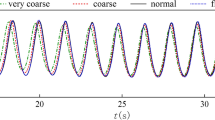Abstract
Surface or submerged horizontal or vertical plate can be considered as a new concept breakwater. This paper investigates the wave-plate interaction of this type of breakwater by use of the boundary element method. The relationships of wave transmitted and reflected among plate thickness, submergence and length are carefully studied by numerical simulation. It is shown that: (1) The transmitted coefficients of submerged horizontal plate or vertical plate will become larger with the increase of plate thickness and reduce rapidly with the decrease of plate submergence. (2) Both surface horizontal and vertical plate are efficient for intermediate and short wave elimination, but vertical plate is more effective. (3) Submerged horizontal plate can act more effectively than submerged vertical plate does. With all wave frequencies, the vertical plate almost has no wave elimination effect.
Similar content being viewed by others
References
Feng, B., Zheng, Y. H., You, Y. G. and He, Z. M., 2007. Interaction of linear waves with infinitely long horizontal cylinders studied by boundary element method, China Ocean Eng., 21(2): 317–330.
Heins, A. E., 1950. Water waves over a channel of finite depth with a submerged plane barrier, Can. J. Math., 2, 210–222.
Ijima, T., Ozaki, S., Eguchi, Y. and Kobayashi, A., 1971. Breakwater and quay wall by horizontal plates, in: Proceedings of the 12th Coastal Engineering Conference, American: ASCE, 1537–1556.
Kojima, 1990. Study on Submerged Horizontal Plate, Fukuoka: Kyushu University.
Maeda, H., 1969. Study on the Scattering Force of Ships of Arbitrary Shape in the Waves, Special speech at the Autumn Lecture of Japanese Shipbuilding Research Association in November Showa 44.
Mclver, M., 1985. Diffraction of water waves by a moored, horizontal, flat plate, J. Eng. Math., 19, 297–319.
Neelamani, S. and Reddy, M. S., 1992. Wave transmission and reflection characteristics of a rigid surface and submerged horizontal plate, Ocean Eng., 19(4): 327–341.
Parsons, N. F. and Martin, P. A., 1992. Scattering of water waves by submerged plates using hyper-singular integral equations, Appl. Ocean Res., 14(4): 313–321.
Patarapanich, M., 1978. Wave reflection form a fixed horizontal plate, in: Proceedings of the International Conference on Water Resources Engineering, Bangkok: AIT, 427–446.
Siew, P. E. and Hurley, D. G., 1977. Long surface waves incident on a submerged horizontal plate, J. Fluid Mech., 83, 141–151.
Stoker, J. J., 1957. Water Waves, Interscience, New York.
Ursell, F., 1947. The effect of a fixed vertical barrier on surface waves in deep water, Mathematical Proceedings of the Cambridge Philosophical Society, 43(3): 374–382.
Usha, R. and Gayathri, T., 2005. Wave motion over a twin-plate breakwater, Ocean Eng., 32(8–9): 1054–1072.
Wang, G. Y., Wang, Y. X. and Li, G. W., 2005. Experimental study of wave-damping performance of multiple layer breakwater, Journal of Dalian University of Technology, 45(6): 90–95. (in Chinese)
Wang, J. L. and Zhu, C., 2000. Application of permeable breakwater in Dayaowan Project, Port & Waterway Engineering, (6): 13–17. (in Chinese)
Wang, K., 2001. Study on the Wave-Eliminating Effect of Submerged Horizontal Plate Type Breakwater, PH. D. Thesis, Dalian University of Technology. (in Chinese)
Yan, Y. X., Zheng, J. H., Zeng, X. C. and Xie, H. D., 1998. Characteristics of wave dissipation for pile foundation tier retainer breakwaters, The Ocean Engineering, 16(1): 67–74. (in Chinese)
Yu, X. P. and Chwang, A. T., 1993. Analysis of wave scattering by submerged circular disk, J. Eng. Mech., ASCE, 119(9): 1804–1817.
Author information
Authors and Affiliations
Corresponding author
Additional information
This work was financially supported by the Scientific Research Foundation for the Returned Overseas Chinese Scholars, Ministry of Education of China (Grant No. 2007[24]) and supported by Science and Technology Project of Dalian (Grant No. 2008A16GX248).
Rights and permissions
About this article
Cite this article
Wang, K., Zhang, Zq. & Xu, W. Transmitted and reflected coefficients for horizontal or vertical plate type breakwater. China Ocean Eng 25, 285–294 (2011). https://doi.org/10.1007/s13344-011-0023-8
Received:
Revised:
Accepted:
Published:
Issue Date:
DOI: https://doi.org/10.1007/s13344-011-0023-8




